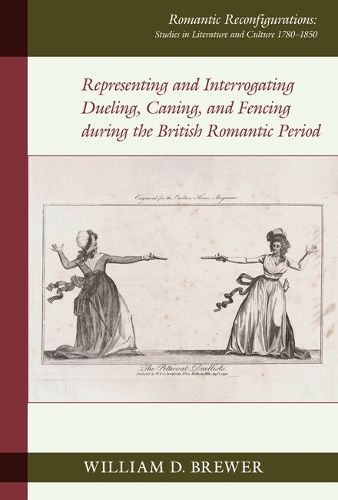Readings Newsletter
Become a Readings Member to make your shopping experience even easier.
Sign in or sign up for free!
You’re not far away from qualifying for FREE standard shipping within Australia
You’ve qualified for FREE standard shipping within Australia
The cart is loading…






Representing and Interrogating Dueling, Caning, and Fencing during the British Romantic Period examines Romantic-era representations of physical interpersonal conflict and the ways in which they reflect, challenge, and subvert gender roles, class hierarchies, and racial and ethnic stereotypes. Along with fictional depictions of one-on-one physical aggression by writers such as Mary Robinson, William Godwin, Walter Scott, Lord Byron, and Mary Shelley, it considers historical accounts of honor violence. While recent studies of honor disputes during the Romantic period have tended to focus on the codified formal duel, this book considers other forms of physical aggression as well, including unritualized duels, assassinations, canings, public fencing bouts, boxing matches, and brawls. William Brewer argues that many Romantic-era Britons found the aristocratic chivalric code compatible with bourgeois commercial values. Although the middle classes were on the ascendant during the decades before the Great Reform Bill, British society continued to affirm the chivalric ideals of honor, physical courage, duty, service, loyalty, and reverence toward women. Romantic-period representations and interrogations of physical conflict and toxic masculinity, along with the affirmative portrayals in Mary Shelley's fiction of pacifistic and nurturing models of masculinity, continue to resonate today and testify to the ongoing struggle to contend with and regulate interpersonal aggression.
$9.00 standard shipping within Australia
FREE standard shipping within Australia for orders over $100.00
Express & International shipping calculated at checkout
Representing and Interrogating Dueling, Caning, and Fencing during the British Romantic Period examines Romantic-era representations of physical interpersonal conflict and the ways in which they reflect, challenge, and subvert gender roles, class hierarchies, and racial and ethnic stereotypes. Along with fictional depictions of one-on-one physical aggression by writers such as Mary Robinson, William Godwin, Walter Scott, Lord Byron, and Mary Shelley, it considers historical accounts of honor violence. While recent studies of honor disputes during the Romantic period have tended to focus on the codified formal duel, this book considers other forms of physical aggression as well, including unritualized duels, assassinations, canings, public fencing bouts, boxing matches, and brawls. William Brewer argues that many Romantic-era Britons found the aristocratic chivalric code compatible with bourgeois commercial values. Although the middle classes were on the ascendant during the decades before the Great Reform Bill, British society continued to affirm the chivalric ideals of honor, physical courage, duty, service, loyalty, and reverence toward women. Romantic-period representations and interrogations of physical conflict and toxic masculinity, along with the affirmative portrayals in Mary Shelley's fiction of pacifistic and nurturing models of masculinity, continue to resonate today and testify to the ongoing struggle to contend with and regulate interpersonal aggression.